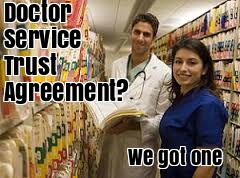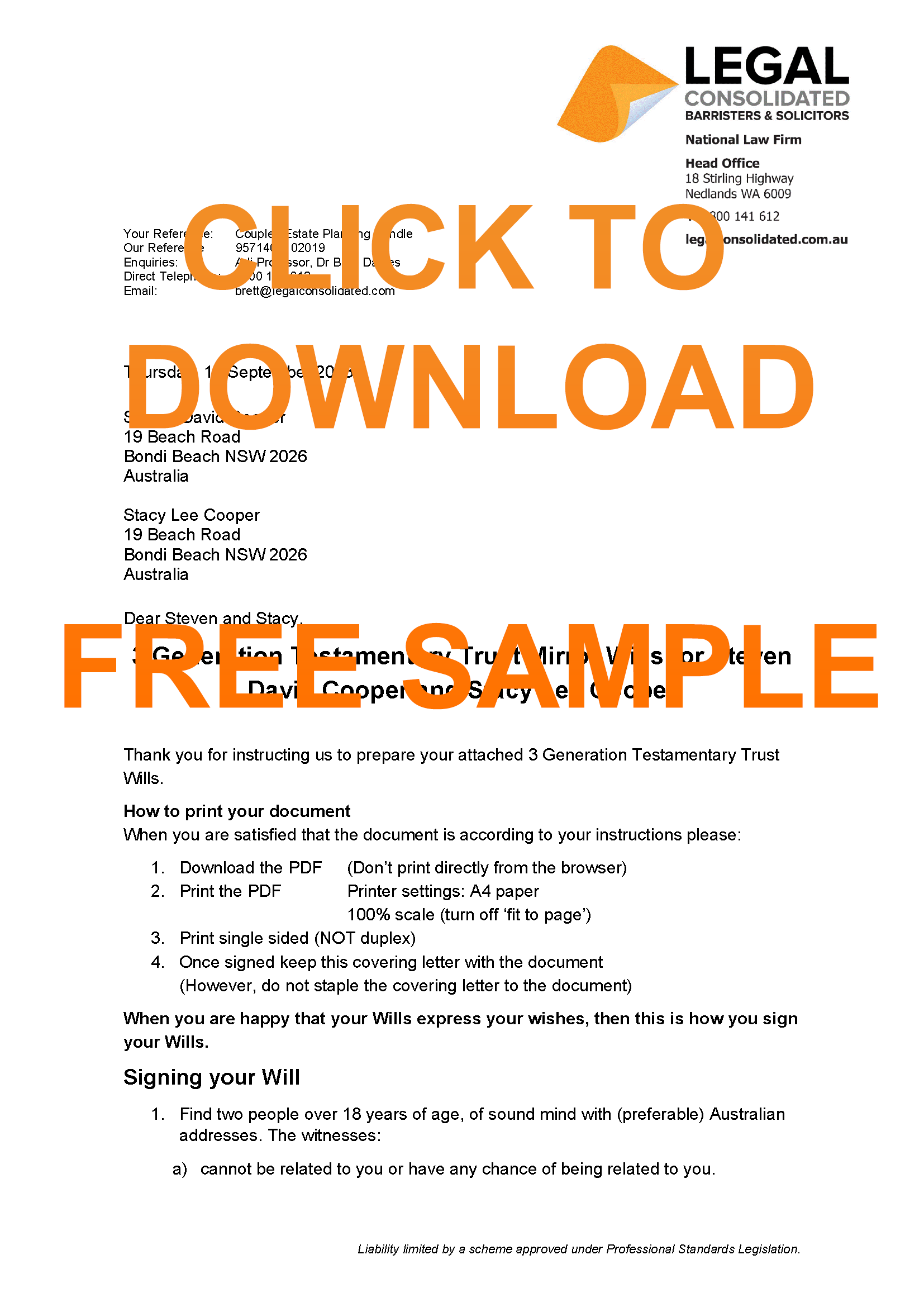Medical Doctor Service Trust Agreement – helps with payroll tax and personal service income (PSI)
Medical doctors can not share profit with their spouses and children. However, there is plenty of work in the medical practice that does not relate to being a doctor.
For example, the hiring of staff, accounting, nurses, receptionists and marketing can be profit centres for another business. This other business is called a Service Trust. The relationship between the Doctor and the Service Trust is called a Doctor Service Trust Agreement.”
Medical Doctor Service Trust Agreement
It is common practice for a Medical Practitioner to use a service trust (service entity). A Legal Consolidated doctor service trust is often a:
- Family Trust – if just one doctor
- Unit Trust – if 2 or more doctors
- Company – not common as profit is trapped and no CGT relief. But useful if you have no family because of the 30% tax rate
Build these 3 types of service trusts on our website.
The medical service trust is a second business. The doctor’s service trust provides services to the doctor. It charges a fee for providing those services. Service trust profits are shared with the doctor’s spouse, children and family. They pay tax at a lower marginal tax rate. Therefore, the service trust saves tax. It helps with superannuation benefits and the spreading of income to the medical doctor’s family members.
But it is not enough to have just a medical service trust. You need an agreement between the doctor and the service trust. This agreement is called a Medical Practitioner Service Trust Agreement. The Service Trust Agreement is a contract. It allows the service trust to supply equipment, staff, receptionist, premises and administration services to the doctor’s practice.
Medical Service Trust Agreements are also popular for:
- Other professionals such as engineers, dentist, lawyers and accountants that cannot otherwise share profit easily.
- Asset protection – one entity holds the high-risk activities (employees, tenancies & advice) the other keeps all the ‘good’ assets (land, intellectual property) in a low-risk entity.
- Companies wanting to liberate wealth and move profit into a trust structure. Unlike a company, the service trust can access the CGT tax concessions. Therefore, the service trust often holds appreciating assets. These include real estate, franchises, copyright and ‘leased out’ business names.
Tax advantages of a medical service trust for the Medical Practitioner
The medical service trust is a separate standalone business. Via the Doctor Service Trust Agreement, it provides services, for a profit, to the Medical Practitioner. The services are provided at ‘market rates’. This is required by the ATO TR 2006/2. The medical service trust then distributes the ‘profit’ it makes. This is from running the business. The profit goes to the non-working spouse, children and other taxpayers at a lower tax rate.
Example of a Medical Practitioner using a Service Trust agreement
The Medical Practitioner brings in revenue of $1.6m. The Service Trust provides services to the doctor. The Doctor Service Trust Agreement sets out the services. Services include cleaning the clinic, providing secretaries, nurses, maintaining doctor’s diary, computers, marketing, office lease and bookkeeping. The service entity owns the equipment and employs all non-medical staff.
The Medical Practitioner Service Trust (via the Service Trust Agreement) charges the doctor $1.4m in fees.
By providing these services the Medical Service Trust makes a profit of $.8m. (This is after it pays its expenses of $.6m.) That profit is distributed to the doctor’s spouse, children and other trust beneficiaries.
Personal Services Income (PSI) for medical doctors
Personal services income (PSI) is income. But it is mainly a reward for an individual’s personal efforts or skills.
You receive PSI in almost any industry, trade or profession. These include:
- financial professionals
- information technology consultants
- engineers
- construction workers
- accountants
- medical practitioners
PSI does not affect the medical doctor if you are an employee receiving only salaries and wages. For example, you work as an employee at a hospital. Obviously, if you are an employee then you personally pay income on the salary or wages you receive.
Operating through a business vehicle may not allow you to escape PSI
If you are operating through an entity, such as a company, partnership or trust, and are an employee of that entity then the PSI rules may still apply. So, hiding behind a company, partnership and trust may not be enough to escape the PSI rules.
The PSI rules treat individuals earning PSI as quasi-employee. The ATO looks through any structures, such as a medical company or trust, which may be in place to attribute the income generated back to the individual who earned that income.
When PSI rules apply, there are limits to deductions that you can claim against this income. In general, a medical doctor who earns PSI is treated as an employee. And they are taxed on their earnings.
The doctor cannot ‘share’ the tax burden on personal services income. However, the service trust ‘income’ is not personal services income. This is because the service trust is a separate business to the doctor’s medical practice. The service trust operates on an ‘arm’s length basis’. Therefore, the income is distributed to the spouse, children and other beneficiaries related to the doctor.
A Medical Service Trust is a type of Independent Contractors Agreement
A medical Service Trust Agreement is a type of Independent Contractors Agreement (‘contract for services’).
The principal (doctor) requests and pays for the services. The person providing the services is the contractor (service trust). The agreement between the principal and contractor is the Medical Practitioner Service Trust Agreement.
- Principal = Medical Practitioner
- Contractor = medical service trust
- Medical service trust agreement = sets out the services provided by the Contractor
The contractor is ‘independent’. The contractor is not an employee of the principal (doctor). In fact, they are (and must be) two separate stand-alone businesses.
What does the Medical Service Trust charge? To comply with payroll tax and PSI
Your accountant, each financial year, tells you what to charge. The Medical Service Trust Agreement allows for this. You charge ‘market rates’. Treat the medical service trust as a separate non-related business. The Medical Service Trust Agreement allows the service trust to provide many services. These include:
(a) plant and equipment (desks, chairs, medical equipment)
(b) non-medical staff to the Doctor (build the Employment Contracts here)
(c) consumables
(d) the premises where the doctor practices from
(e) budgeting, forecast, bookkeeping, accounting and debt collection services for the GP
(f) marketing, corporate design and identity and brand awareness of the doctor’s practice
(g) additional services — as agreed by the parties from time to time
(h) providing money and capital to fund the medical practice
(I) Service Trust provides clinical equipment, after talking with accountants and looking at what cuts the mustard with the ATO, we have seen:
-
- Peak flow meter
- Pen torch
- Spirometer Scales (adult and paediatric)
- Sphygmomanometer
- Tape measure
- Tendon hammer
- Thermometer
- Tuning forks – 128 Hz vibration sense
- Vaginal speculum (stainless steel or disposable)
- Wood’s(UV)lamp
- Auriscope
- Blood glucose monitor
- ECG
- Eye charts – visual acuity (Snellen) – colour vision (Ishihari)
- Examination lights
- Monofilament – 10 g for pressure sense testing
- Oximeter
- Ophthalmoscope – 256 Hz and 512 Hz hearing
- Cryotherapy spray and liquid nitrogen tank
- Dermatoscope
- Digital camera
- Diathermy
- Vaccine fridge
- Oxygen cylinder, regulator, masks and tubing
- Laryngoscope and intubation set
- IV cannulation sets, tourniquet
- Spacer for administering bronchodilator
- Doctor’s bag emergency supplies
- Aspirin, paracetamol, antibiotic eye ointment
- Doppler for fetal heart and arterial pulses
- Ear irrigation device
- Magnification loupe
- Plaster saw
- Steriliser
- Surgical equipment for minor procedures
- Lighting for Pap smears and procedures
- Self-illuminated vaginal speculate
- Audiometer
(J) Additional services. GP Service Trust can provide pathology, collection centres and Pharmacy support.
- Onsite Pathology
- Following deregulation, more approved pathology collection centres are being located in medical practices, providing improved patient convenience. Pathology companies value co-location highly and it is also beneficial for patients. However, it is important to observe the legislation that exists to prevent inappropriate incentives for referrals.
- Collection centres
- May require a dedicated floor area that is not shared at any time.
- Pharmacy on site
- With the latest changes to remove distance restrictions, in some States, for the location of pharmacies, opportunities now exist to bring pharmacists much closer to your medical surgery. This both improves patient convenience and strengthens the relationship between doctors and pharmacists. Allied Health Renting space to other health professionals also helps with the service trust relationship. Talk with your insurance adviser, especially regarding your medical indemnity insurance.
How do I update the Doctor Service Trust Agreement?
The Medical Agreement is updated by an exchange of emails. Add more services as your accountant suggests. You can add a scope of work, plans, diagrams and specifications.
The Medical Service Trust Agreement is silent on what it charges the medical practitioner. So that it is never out of date. Your accountant advises you on what the appropriate charges are during the financial year.
How do I set up a Doctor’s service trust structure?
Talk with your accountant. Your accountant, for a single doctor with rooms, will:
- First, build a company as trustee for a family trust
- Secondly, once my lawyers have checked and incorporated the company then build a family trust deed
- Finally, build this Doctors Service Trust Agreement (just press the Start Building button on the top of this page)
Estate Planning Standards
Help build the Medical Service Trust Agreement
Need a hand answering the question as you build the Medical Practitioner Service Trust Agreement? Just telephone us. But attempt the free building process first.
Medical service trust owning and leasing cars to a doctor?
Q: I want the medical service trust to own some cars. Can the service trust lease the car for use by the doctor? Can the staff of the Medical Service Trust also lease a car?
A: The medical service trust is a stand-alone business. It provides services to a doctor. This is on an arms-length basis. As a stand-alone business (like, say AVIS Rent a Car), a business can lease a car to a doctor. Therefore, the Legal Consolidated medical service trust can do so as well. Just include cars and motor vehicles in the list of services in the Service Trust Agreement.
However, there are accounting questions, which we cannot answer, as we are lawyers. And we also do not know your individual circumstances. Such questions that your accountant will ask is ‘what percentage of the vehicle is used by the doctor to create income’ etc… Obviously, the services provided by the Service Trust must be to create income and revenue for the doctor.
Your second question does not relate to service trusts. The service trust is a separate business providing services and products to a doctor. A business (which is what a service trust is) providing services to its own staff is another matter. We do not provide advice on this, as it has nothing to do with a Service Trust Agreement.
To put it another way, the relationship between the service trust and the doctor is a B:B relationship. This is Business to Business. Who the Service Trust employs is a separate employment matter between the service trust and its employees. It has nothing to do with a Service Trust Agreement. It is not relevant to the B:B relationship.
What is the best business structure for a General Practitioner (GP) in Australia?
Most GPS work in a one-to-one relationship. General practitioners work in a range of different structures – employee, associate, partnership, independent contractor, company shareholder or director.
Q: Is the medical Service trust a ‘normal trust’? The only difference is the doctor service trust agreement.
We are not giving advice on Service Trusts on this page. Rather, we are giving advice on the ‘glue’ between the Service Trust and the doctor. This is called a Service Trust Agreement.
However, since, you ask, any of these vehicles prepared by Legal Consolidated can potentially be used as a service trust:
Business Structures for Personal Services Income, tax and asset protection
Family trust v Everett’s assignments
- Family Trust Deed – watch the free training course
- Family Trust Updates:
- Everything – Appointor, Trustee & Deed Update
- Deed ONLY – only update the Deed for tax
- Guardian and Appointor – only update the Guardian & Appointor
- Change the Trustee – change human Trustees and Company Trustees
- The company as Trustee of Family Trust – only for assets protection?
- Bucket Company for Family Trust – tax advantages of a corporate beneficiary
Unit trust vs Everett’s assignments
- Unit Trust
- Unit Trust Vesting Deed – wind up your Unit Trust
- Change Unit Trust Trustee – replace the trustee of your Unit Trust
- Company as Trustee of Unit Trust – how to build a company designed to be a trustee of a Unit Trust
Corporate structures and Everett’s assignments
- Partnership Agreement – but what about joint liability?
- Incorporate an Australian Company – best practice with the Constitution
- Upgrade the old Company Constitution – this is why
- Replace lost Company Constitution – about to get an ATO Audit?
- Independent Contractor Agreement – make sure the person is NOT an employee
- Service Trust Agreement – operate a second business to move income and wealth
- Law firm Service Trust Agreement – how a law firm runs the backend of its practice
- Medical Doctor Service Trust Agreement – complies with all State rules, including New South Wales
- Dentist Service Trust Agreement – how dentists move income to their family
- Engineering Service Trust Agreement – commonly engineers set up the wrong structure
- Accountants Service Trust Agreement – complies with ATO’s new view on the Phillips case


